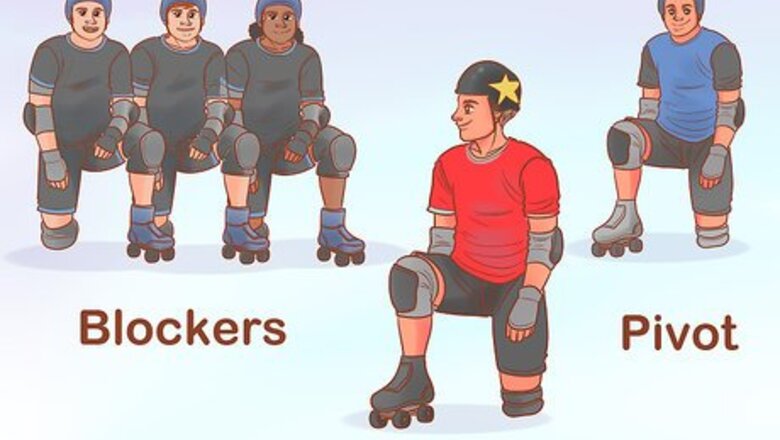
views
Choosing Your Team, Equipment, and Track

Get 5 people to play and assign each player a position. A roller derby team is actually made up of 14 players who cycle in and out of the game as needed to give their teammates a break. However, only 5 people are on the track at 1 time. The positions are as follows: 1 Jammer. Jammers score points for their team by skating past the pack. 1 Pivot. Pivots do the same job as the blockers, but they can become jammers if someone passes the star to them. 3 Blockers. The blockers try to prevent the jammer from passing the pack.

Get someone to be the referee for a professional game. If you are playing in a league, then you will also need a referee. A referee is responsible for calling and enforcing penalties on both teams. However, if you are just playing for fun with your friends, then having a referee is optional. You can just enforce the rules for yourselves during the game. In a professional roller derby game, the referee uses several hand signals to indicate the type of penalty they are calling. However, you won’t need to learn these if you are just playing for fun!

Ensure that everyone has the proper equipment. Each team member will need a pair of skates to play roller derby. Roller derby is also a rough sport so players will need to wear protective gear as well including: A helmet (Jammers have a star on their helmets, and pivots have a slash on their helmets.) Mouthguard Wrist guards Elbow pads Knee pads Turtle shell bra (optional) Padded shorts (optional) Chin, shin, and nose guards (optional) Supports for your knees and ankles (optional) Tailbone protector (optional)
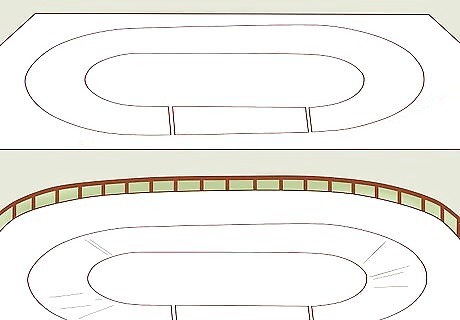
Play on a flat track or a banked track. A flat track is an oval-shaped rink with lines designating the borders of the rink, plus 2 sets of lines along the straight parts of the rink. The lines indicate the starting area for the players. A banked track is set up the same way, except that the track is at a slight angle all the way around it, which may allow players to skate faster. You will most likely have to play on a flat track unless your local roller derby team has their own banked track.
Starting the Jam
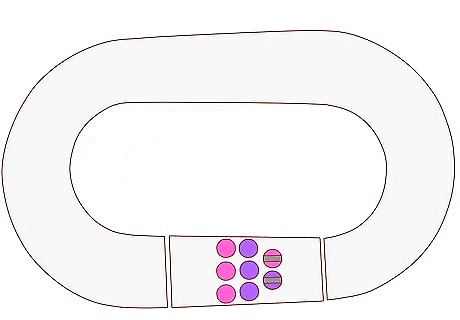
Get the blockers and pivots on the straight portion of the track. The blockers and pivots of both teams are known collectively as the pack. They cannot be more than 10 feet (3.0 m) away from each other at any time during a jam. When the game starts, the pack should be positioned between the 2 lines on the straight portion of 1 side of the track, and they will all move forward together as they work to block each other’s jammers and help their own jammer’s get through.

Position the jammers behind the pack before each jam starts. The jammers always start the jam behind all of the other players. This is because their goal is to work their way through the pack to earn points. Each team’s jammer will need to get through the pack when the jam starts to earn points for their team.
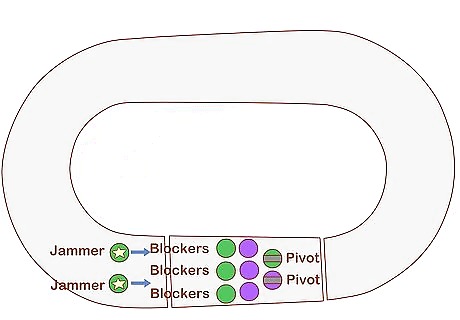
Begin timing the skaters for a jam (2 minutes) once they start moving. Once the jam begins, the timer starts as well. Each jam lasts for 2 minutes, and the jammers must try to earn as many points as possible for their teams by skating past the pack.

Start a new jam after 1 jam ends. After 1 jam ends, a new 1 begins 30 seconds after the last jam. There are two 30-minute halves in a game of roller derby consisting of 15 jams per half. The team with the most points at the end of the second 30-minute half wins the game.
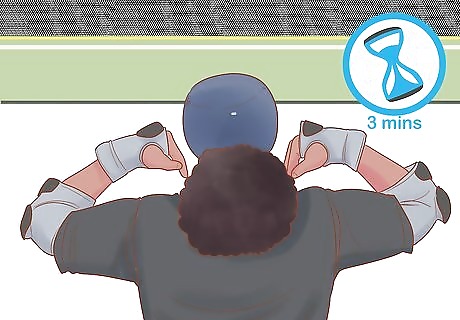
Take up to three 1-minute time outs during the game. Each team gets three 1-minute time outs that they can take as needed. It is best to save these for when players need a moment to talk strategy. If your team wants to take a time out, have 1 of your team members on the track call it out between jams, such as by saying “time out!” to the referee or the other team. This will extend the time between jams to 1 minute and 30 seconds rather than just 30 seconds. Keep in mind that the clock continues to run between jams, so each of the 30-second intervals between jams is counted as part of the total game time. However, if your team calls a time out, then the 1-minute time out is not counted towards the game total.

Swap out players between jams as needed. If a player needs a break, a player gets injured, or if you want to swap out a player for strategic reasons, then you can do this in the 30-second space between jams. Game play may be halted by the referee if someone is injured, and a new jam will start after the injured player is taken off the rink.
Scoring Points for Your Team
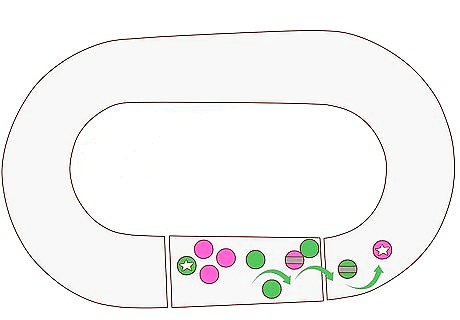
Try to pass the pack if you are a jammer. You will earn your team 1 point for each of the other team’s players you pass, so you can get a maximum of 5 points for each pass. However, keep in mind that the other team’s jammer can earn points at the same time as you, so you may end up being tied until 1 of you can get past when the other jammer can’t. For example, if the jammer passes the other team’s blockers, pivot, and jammer, then they would earn their team 5 points. If you just pass the blockers and pivot while the other team’s jammer is ahead of you, then you will only be earning your team 4 points.

Prevent the other team’s jammer from passing if you are a blocker. Your main objective as a blocker is to prevent the other team’s jammer from getting past you because that is how they score points for their team. To block the jammer, you can position yourself in front of them, and even use your body to push them back. However, you cannot hit the other team’s players with your head, elbows, forearms, hands, knees, or feet. For example, you could block the other team’s jammer by pushing them with your shoulders and hips, but you cannot punch, knee, headbutt, or kick the other team’s jammer to block them.
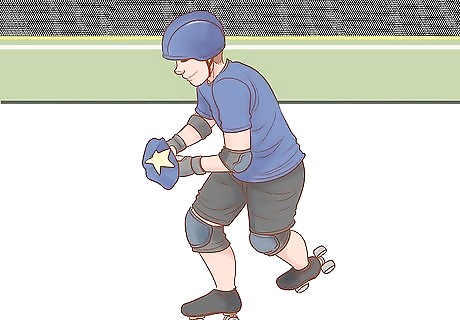
Pass the star to your team’s pivot if you cannot get through the pack. If you have been battling with the other team’s blockers and just cannot get through them, then you might want to pass the star on your helmet to your team’s pivot as a way to help your team score. The star is attached by Velcro, so it comes right off and the pivot can put it onto their helmet. The pivot can then try to get through the pack and score in your place. Keep in mind that the pivot will be considered the new jammer to the end of the jam. The jammer will then get the star back at the beginning of the next jam.

Touch your hips to end the jam if you are the lead jammer. If you are in front of the other team’s jammer, you are the lead jammer. This means you can end the jam early by touching your hips with your hands. If your team is ahead on points, then ending the jam early would be an advantage for your team because it will prevent the other team from earning additional points before the time is up. For example, if your team has 8 points, and the other team has 4 points, ending the jam with 30 seconds to spare might be a good move.
Following the Rules

Stay inside the track and re-enter behind the pack if you go out. If you go outside of the pack, you will have to re-enter the track behind the pack. If you do not re-enter behind the pack, then this is considered a penalty. For example, if you are the jammer and you go outside of the track while trying to pass the pack, then you will have to go back into the track from behind the pack, even if you made it past them when you went outside of the pack.

Stay with the pack if you are a blocker or a pivot. Blockers and pivots must stay with the pack (the other blockers and pivots) or the referee may stop the jam and call “no pack.” This is because the pack is necessary to play roller derby, so it must stay intact through the entire jam. For example, do not try to pursue the other team’s jammer if they pass you. Just wait for them to come back around again.

Block other players with your body and avoid using certain body parts. If you hit another team’s player with your hands, elbows, head, knees, or feet, then you will receive a penalty for hitting. Roller derby is a full-contact sport, but it is not meant to be an all-out brawl. Stick to blocking other players with your body from the neck down to your knees and from above your elbows. For example, if you punch another player in the stomach with your fists to block them, you would receive a penalty and have to sit out for 30 seconds.

Assign 30-second penalties when someone breaks a rule. You can designate a penalty area off of the track, such as a bench or a few chairs. When someone breaks a rule, they will have to go to the penalty area for 30 seconds, which means their team will have 1 less player for that portion of the jam. The referee is responsible for serving and enforcing penalties in a professional league game, but you can always self-enforce penalties if you are just playing roller derby with some friends.




















Comments
0 comment